Schneider P., Eberly D.H. Geometric Tools for Computer Graphics
Подождите немного. Документ загружается.


574 Chapter 11 Intersection in 3D
e = d tan(β)
= d tan(
π
2
− 2α)
= d cot(2α)
= d cot(π − 2θ)
=−d cot(2θ)
= d
tan(θ) − cot(θ)
2
By observing Figure 11.48, we see that the plane intersects the cone’s axis at a distance
2h from the cone’s vertex, and so we have
cos(θ) =
2h
d
or
h =
d
2cos(θ )
We can now compute the parabola’s vertex and focus:
V
p
= V + d ˆn + e ˆv
F = V + h ˆa +r ˆv
We could easily use these formula for computing f , the focal length. However,
we can produce a more compact formula. Consider the triangle FCV
p
:itisaright
triangle with acute angle γ = π/2 − θ, and one leg is clearly r. The other leg we
denote as x. By trigonometry, we have
tan(γ ) =
x
r
But we know that r = d/2 (Equation 11.26), so we can rewrite the above as
tan(π/2 − θ) =
x
d
2
Recall from trigonometry these facts:
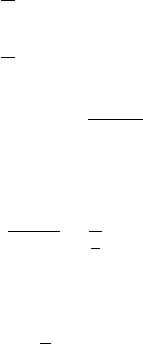
11.7 Planar Components and Quadric Surfaces 575
cos(
π
2
− α) = sin(α)
sin(
π
2
− α) = cos(α)
tan(α) =
sin (α)
cos(α)
We can rewrite this as
1
tan(θ)
=
x
d
2
or
x =
d
2
cot(θ )
The pseudocode for this case is the following (Miller and Goldman 1992):
float d = Dot(plane.base - cone.vertex, plane.normal);
float cosTheta = Dot(plane.normal, cone.axis);
float sinTheta = Sqrt(1 - cosTheta * cosTheta);
float tanTheta = sinTheta / cosTheta;
float cotTheta=1/tanTheta;
float e = d/2 * (tanTheta - cotTheta);
// Parabola is {V, u, v, f}
Vector v = Normalize(cone.axis - cosTheta * plane.normal);
Vector u = Cross(v, plane.normal);
Point V = cone.vertex+d*plane.normal+e*v;
float f = d/2 * cotTheta;
A circular intersection occurs when the plane normal ˆn is parallel to the cone axis
ˆa; that is, if |ˆn ·ˆa| <, as shown in Figure 11.49. Computing the circle is simple:
clearly, the center of the circle C is
C =V − h ˆa
where h is the (signed) distance from the plane to V , the cone vertex. The circle’s
normal is of course just the plane’s normal ˆn; the radius r can be computed with
simple trigonometry:
r =h tan(α)
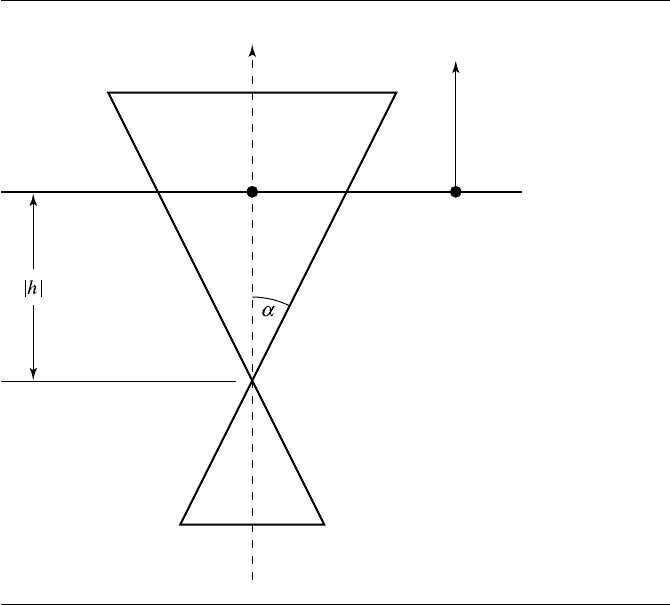
576 Chapter 11 Intersection in 3D
P
C
r
â
ˆn
Figure 11.49 Circular curve intersection of plane and cone. After Miller and Goldman (1992).
The pseudocode is the following (Miller and Goldman1992):
// Signed distance from cone’s vertex to the plane
h = Dot(cone.vertex - plane.point, plane.normal);
circle.center = cone.vertex-h*plane.normal;
circle.normal = plane.normal;
circle.radius = Abs(h) * Tan(cone.alpha);
An elliptical intersection occurs when cos(θ) = sin(α), but when the plane nor-
mal ˆn and cone axis ˆa are other than parallel, as shown in Figures 11.50 and 11.51.
An ellipse is the intersection if cos(θ) > sin(α), and a hyperbola is the intersection if
cos(θ) < sin(α). To define the ellipse or hyperbola, we first must determine the cen-
terpoint C. By definition, this is a point halfway between the foci: C =(F
0
+ F
1
)/2.

11.7 Planar Components and Quadric Surfaces 577
P
r
0
r
2
C
0
C
1
2r
u
F
1
F
0
ˆn
â
Figure 11.50 Ellipse intersection of plane and cone. After Miller and Goldman (1992).
We h ave
F
0
= V +
r
0
sin(α)
− r
0
ˆn
F
1
= V +
r
1
sin(α)
− r
1
ˆn
where r
0
and r
1
are the two radii indicated by Equation 11.25. In the case of the ellipse,
the relationship between cos(θ) and sin(α) gives us positive values for r
0
and r
1
, and
the spheres lie on opposite sides of the plane, but on the same side of the cone; in the
case of the hyperbola, the relationship between cos(θ ) and sin(α) givesusanegative
value for r
0
and a positive value for r
1
, and the spheres lie on the same side of the
plane, but on the opposite sides of the cone.
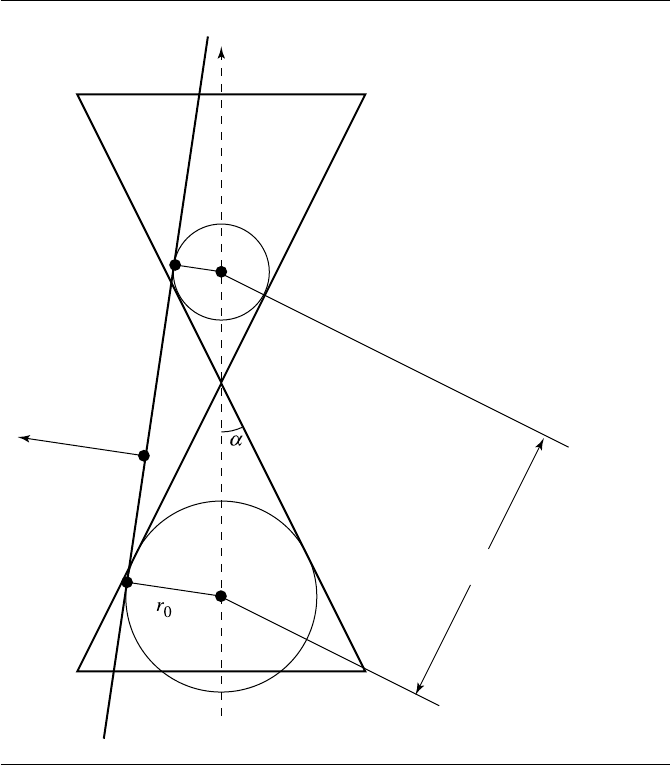
578 Chapter 11 Intersection in 3D
P
C
0
C
1
r
1
2r
u
F
0
F
1
ˆn
â
Figure 11.51 Hyperbola intersection of plane and cone. After Miller and Goldman (1992).
If we substitute the two versions of Equation 11.25 into the formula for the
foci, and then substitute this into the formula for the center, we get (after some
manipulation)
C =V + h cos(θ) ˆa − h sin
2
(α) ˆn
where

11.7 Planar Components and Quadric Surfaces 579
t = (P − V)·ˆn
b = cos
2
(θ) − sin
2
(α)
h =
t
b
Next come the directrix and focus vectors ˆu and ˆv. If we note that C, F
0
, and F
1
all lie in the plane parallel to the family of planes containing ˆa and ˆn, we see that
ˆu =
ˆa −cos(θ) ˆn
ˆa − cos(θ) ˆn
and so
ˆv =ˆn ·ˆu
The major and minor radii computations are a bit more involved, and here we
follow Miller and Goldman (1992) closely: recall that a characteristic of the tangent
spheres for the cone-plane intersection is that the major radius is half the distance
along a ruling between the circles of tangency between the spheres and the cone. For
the ellipse, this gives us
r
u
=
1
2
r
0
tan(α)
−
r
1
tan(α)
= h sin(α) cos(α)
and for the hyperbola
r
u
=
1
2
r
1
tan(α)
−
r
0
tan(α)
= h sin(α) cos(α)
Note that in both cases, r
u
is positive.
If we define d to be the (positive) distance between the center C and the foci, then
the minor radius of the ellipse is
r
v
=
r
2
u
− d
2
u
and for the hyperbola
r
v
=
d
2
u
− r
2
u
Again, note that in both cases, r
v
is positive.

580 Chapter 11 Intersection in 3D
The center C is halfway between the foci, so d is half the distance between the
foci, and thus
d
2
=
1
4
(F
0
− F
2
) · (F
0
− F
2
)
If we substitute the formulas for F
0
and F
1
, and then substitute the formulas for
r
0
+ r
1
and r
0
− r
1
,weget
r
v
= t
sin(α)
√
b
The pseudocode is the following (Miller and Goldman 1992):
// Compute various angles
cosTheta = Dot(cone.axis, plane.normal);
cosThetaSqared = cosTheta * cosTheta;
sinAlpha = Sin(cone.alpha);
sinAlphaSquared = sinAlpha * sinAlpha;
cosAlpha = Sqrt(1 - sinAlphaSquared);
t = Dot(plane.point - cone.vertex, plane.normal);
b = cosThetaSquared - sinAlphaSquared;
h = t/b;
// Output is ellipse or hyperbola
center = cone.vertex+h*cosTheta * cone.axis
- h * sinAlphaSquared * plane.normal;
majorAxis = Normalize(cone.axis - cosTheta * plane.normal);
minorAxis = Cross(plane.normal, ellipse.u);
majorRadius = Abs(h) * sinAlpha * cosAlpha;
minorRadius=t*sinAlpha / Sqrt(Abs(b));
if (cosTheta > sinAlpha) {
// Ellipse
ellipse.center = center;
ellipse.majorAxis = majorAxis;
ellipse.minorAxis = minorAxis;
ellipse.majorRadius = majorRadius;
ellipse.minorRadius = minorRadius;
return ellipse;
} else {
// Hyperbola
hyperbola.center = center;
hyperbola.majorAxis = majorAxis;
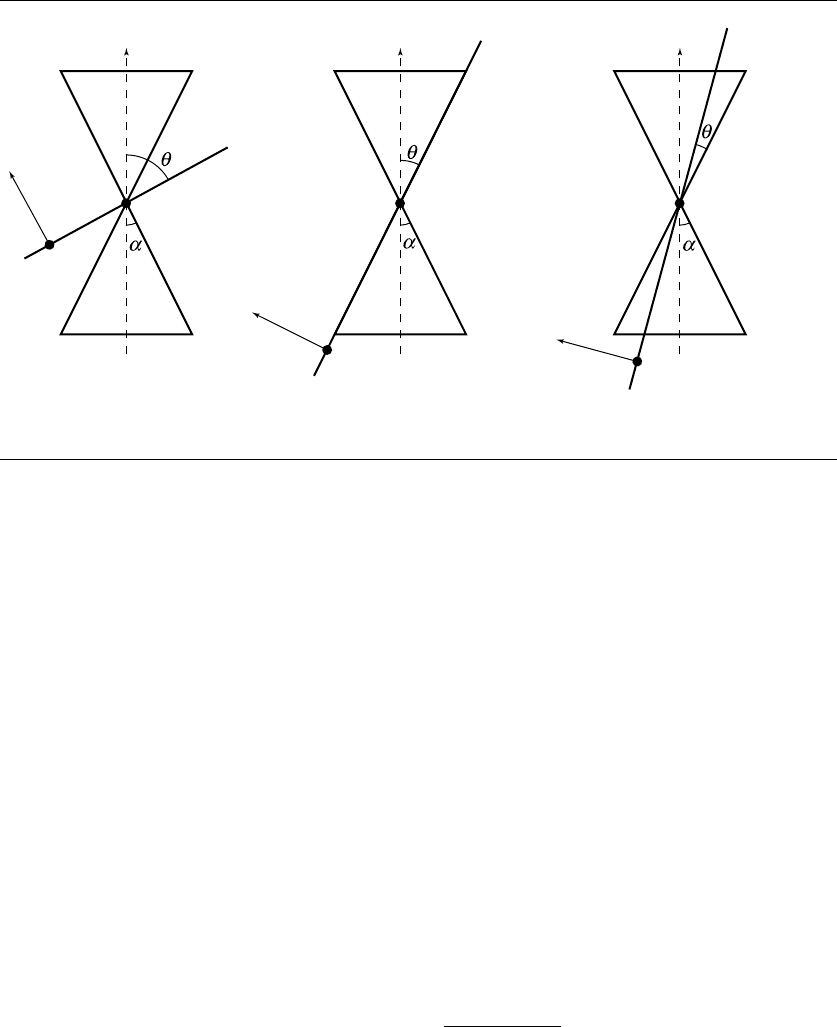
11.7 Planar Components and Quadric Surfaces 581
P
P
Single point Single line
V
V
ˆn
ˆn
ââ
P
Two lines
V
ˆn
â
Figure 11.52 Degenerate intersections of a plane and a cone. After Miller and Goldman (1992).
hyperbola.minorAxis = minorAxis;
hyperbola.majorRadius = majorRadius;
hyperbola.minorRadius = minorRadius;
return hyperbola;
}
Degenerate Plane-Cone Intersections
In order to distinguish between the three degenerate intersections, we consider the
angle between the cone’s axis ˆa and the plane’s normal ˆn, and its relationship to the
half-angle α defining the cone. In each case, however, the plane contains the cone’s
vertex. The degenerate intersections are shown in Figure 11.52.
The intersection is a point if cos(θ) > sin(α).
The intersection is a single line if cos(θ) = sin(α). Clearly, the line passes through
the cone vertex V , and so this can be the base point of the intersection line. Since the
line lies in a plane parallel to the family of planes containing ˆv and ˆa, its direction is
ˆa −cos(θ) ˆn
ˆa − cos(θ) ˆn
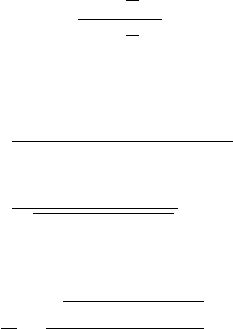
582 Chapter 11 Intersection in 3D
The intersection is two lines if cos(θ ) < sin(α). Again, the lines pass through the
cone vertex V , and so this can be the base point of the lines. As Miller and Gold-
man point out, these lines can be considered to be the asymptotes of a degenerate
hyperbola:
ˆ
d =
ˆu ±
r
v
r
u
ˆv
ˆu ±
r
v
r
u
ˆv
From the previous section, we have
r
u
=
((P − V)·ˆn) sin(α) cos(θ)
sin
2
(α) − cos
2
(θ)
r
v
=
((P − V)·ˆn) sin(α)
sin
2
(α) − cos
2
(θ)
and thus
r
v
r
u
=
sin
2
(α) − cos
2
(θ)
cos(θ)
The pseudocode is the following (Miller and Goldman 1992):
// Assuming that Abs(Dist(cone.vertex, plane)) < epsilon...
if (Cos(theta) > Sin(alpha)) {
// Intersection is a point
intersectionPoint = cone.vertex;
} else if (Cos(theta) == Sin(alpha)) {
// Intersection is a single line
line.base = cone.vertex;
line.direction = Normalize(cone.axis - Cos(theta) * plane.normal);
} else {
// Intersection is two lines
u = Normalize(cone.axis - Cos(theta) * plane.normal);
v = Cross(plane.normal, u);
sinAlpha = Sin(alpha);
cosTheta = Cos(theta);
rVOverRU = Sqrt(sinAlpha * sinAlpha - cosTheta * cosTheta)
/ (1 - sinAlpha * sinAlpha);
line0.base = cone.vertex;
line0.direction = Normalize(u + rVOverRU * v);
line1.base = cone.vertex;
line0.direction = Normalize(u - rVOverRU * v);
}

11.7 Planar Components and Quadric Surfaces 583
11.7.5 Triangle and Cone
Let the triangle have vertices P
i
for 0 ≤i ≤ 2.TheconehasvertexV , axis direction
vector a, and angle θ between axis and outer edge. In most applications, the cone
is acute, that is, θ ∈ (0, π/2). This book assumes that, in fact, the cone is acute, so
cos θ>0. The cone consists of those points X for which the angle between X − V
and a is θ. Algebraically the condition is
a ·
X − V
X − V
= cos θ
Figure 11.15 shows a 2D representation of the cone. The shaded portion indicates
the inside of the cone, a region represented algebraically by replacing “=” in the above
equation with “≥”.
To avoid the square root calculation X − V , the cone equation may be squared
to obtain the quadratic equation
a ·(X − V)
2
= (cos
2
θ)X − V
2
However, the set of points satisfying this equation is a double cone. The original cone
is on the side of the plane a · (X −V)=0 to which a points. The quadratic equation
defines the original cone and its reflection through the plane. Specifically, if X is a
solution to the quadratic equation, then its reflection through the vertex, 2V − X,is
also a solution. Figure 11.16 shows the double cone.
To eliminate the reflected cone, any solutions to the quadratic equation must also
satisfy a · (X − V)≥ 0. Also, the quadratic equation can be written as a quadratic
form, (X −V)
T
M(X − V)= 0, where M = (aa
T
− γ
2
I) and γ = cos θ . Therefore,
X is a point on the acute cone whenever
(X − V)
T
M(X − V)= 0 and a · (X − V)≥ 0
Test Intersection
Testing if a triangle and cone intersect, and not having to compute points of in-
tersection, is useful for a couple of graphics applications. For example, a spotlight
illuminates only those triangles in a scene that are within the cone of the light. It is
useful to know if the vertex colors of a triangle’s vertices need to be modified due
to the effects of the light. In most graphics applications, if some of the triangle is il-
luminated, then all the vertex colors are calculated. It is not important to know the
subregion of the triangle that is in the cone (a result determined by a find query).
Another example is for culling of triangles from a view frustum that is bounded by a
cone for the purposes of rapid culling.
